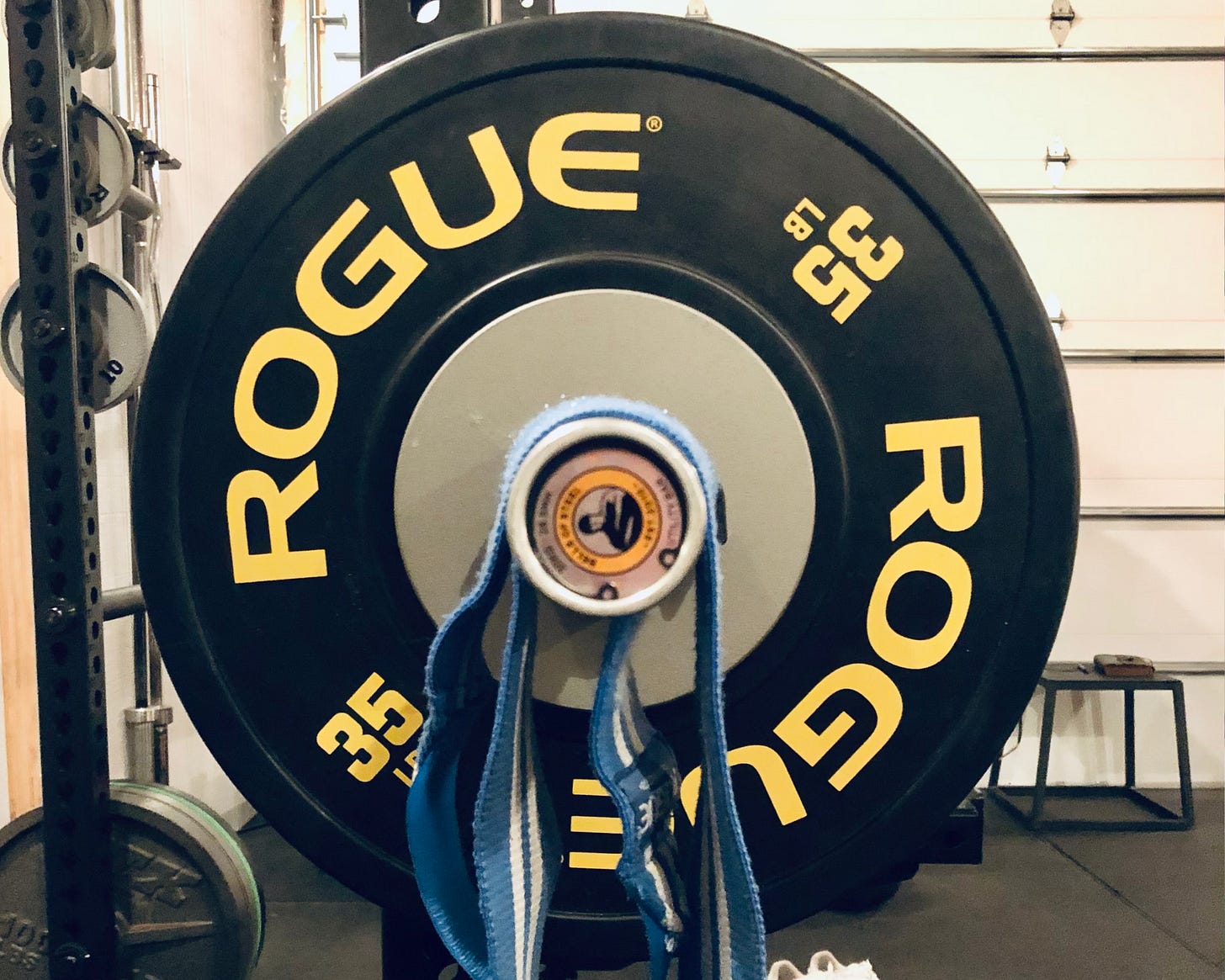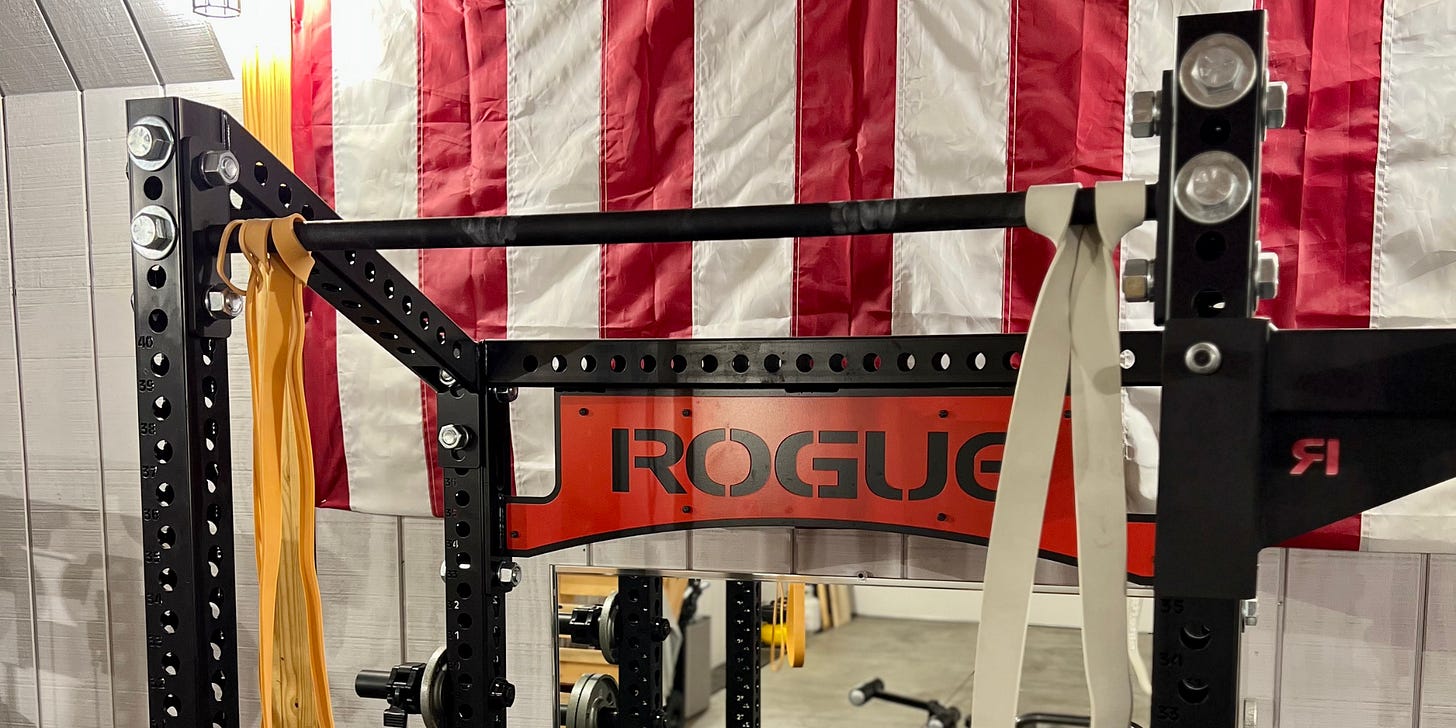The Training Day Narrative
Every workout you do can be an intense, motivating, and teaching story.
In this article:
A narrative, designed to help you understand the sensations and thoughts that come with an intense and effective training day.
A checklist for setting yourself up for gym success, every time.
Every Workout is a Story
I believe each workout of your life, even if it’s not perfect, could be transformed into a short story, capable of motivating and inspiring someone, somewhere. This article is going to take you through one of my own training days from start to finish. This will help you understand how intense/effective workouts feel and give you incite into how I push through voluntary hard work. My hope is to teach you several new things, but also to inspire you to push yourself in the gym.
Today’s Story Begins Here
The location was my home gym, right in the middle of New Prague, MN. New Prague is a small town with plenty of active people, which is exactly why I like it.
I was just getting started with a new block of GST programming; Macrocycle 1/Microcycle 1, to be exact. My training day was Squat Day, which is focused on squatting musculature (quads and glutes primarily, with a secondary focus on hamstrings and calves), upper back (because I always do upper back as part of my lower body days), and abs (abs are part of every lower body GST workout).
My core lift, which is the primary lift of the day, was the barbell box squat. I began this session as I often do; with a short, low intensity ride on my Rogue Echo Bike. I casually rode my way through a couple of songs and called it good. Time to lift…
Enough with the easy stuff, it was time to get under the bar and move something! My squat rack needed to be set up and adjusted so I set the safety arms to the correct height and adjusted the j-hooks to my height. Making sure your squat rack is set up correctly is essential to having the best training session possible.
Pro Tip: Never forget your safeties, especially when you consider that a squat failure without them could end your life. It does happen.
I grabbed my squat box and placed it in the middle of the rack. At this point I was ready to go. I stood in front of the box for a few seconds, thinking about my first set. Finally, I took a few steps forward to get under the empty barbell, placed it in the low bar position on my rear delts, and un-racked it. I made sure to take a step or two back with each foot to ensure that the barbell wouldn’t be crashing into the j-hooks during the reps to come.
I proceeded to focus on form while I performed my first warm up set for 10 practice reps. I always use an empty bar for my first warm-up set, and I recommend you do the same. Of course the reps were simple, the weight was light, and an outsider might think I was wasting my time. However, I knew that I had just told my body what to expect and alerted my nervous system to prepare for what was to come in the very near future.
That first warm-up set had purpose. They always do.
I proceeded to add 35lbs to the bar and my second warm up set was underway. I made sure to drop my rep count down a few notches, hitting 8 focused and tight reps. I knew that these warm-up sets were priming my nervous system for the heavier work ahead. Warm-up sets are a signal for your body and mind. They are meant to sound your body’s alarm; a working set storm is on the horizon! After completing my second warm-up set, I added another 35lbs to the bar for a total weight of 115lbs.
I felt the need to narrate this training day so you would have the opportunity to visualize how you should complete your warm-ups and working sets. My complete warm-up/working sets went as follows:
Warm-Up Set 1: 45 x 10
Warm-Up Set 1: 80 x 8
Warm-Up Set 1: 115 x 5
Warm-Up Set 3: 150 x 2
Working Set 1: 180 x 8
Working Set 2: 180 x 8
Working Set 3: 180 x 18
As you can see, my warm-ups serve the purpose of preparing my body and mind for the heavier working set poundage. I am priming my system, but not fatiguing myself in doing so. You don't want to be wasting energy on your warm-ups. Get under the warm-up weight briefly and let your body react to it.
To understand the principles behind my warm-up routine, read my Warming Up article:
When it comes to working sets, this is when you put your time in under the iron and force results.
Going forward, I knew I could complete my 8 working set goal reps because I was following GST’s pre-planned core lift schedule. I knew I could handle the weight because I did not over-estimate my 1RM during testing week, keeping my periodization numbers accurate and customized to my abilities. This day’s core schedule called for three working sets, each with 60% of my previously determined 1RM:
Working Set 1: 60% 1RM x 8
Working Set 2: 60% 1RM x 8
Working Set 3: 60% 1RM x AMRAP (As Many Reps As Possible)
When you know you can get your numbers, you have the ability to focus on form, mind/muscle connection, and overall execution of each rep. This is exactly what I did with my working sets. Un-racking the weight, I already knew I had 8 reps to complete. I viewed the set as an opportunity; a chance to complete those 8 reps as perfectly as possible.
When you view your working sets as an opportunity to do your best, you'll put more focus and effort into them.
When it came time for my AMRAP set, I knew it was time to step up my game. Read more about the AMRAP mindset and benefits here:
Setting up under the bar with my usual routine, I knew this was not going to be a 'usual' set. You get one shot at your AMRAP set, so you have to approach it with determination. As I un-racked the bar, I knew that 8 reps was a done deal. I just didn't know how far past that mark I’d venture. The initial 8 reps weren't exactly easy, but they came and went.
With each rep from that point on I continued to take large breaths of air, breathing in deep before descending into the squat position, bracing my core tight as I began to rise back up, and forcefully expelling my breath towards the top before resetting, breathing back in deeply, and repeating the process. With each new rep reaching further and further into those double digits, the bar began to feel heavier and heavier. The burn was building up in my quads and glutes and my heart rate was increasing.
In the end, you simply need to decide how far you’re willing to take the set. I told myself, as I always do, you have only one AMRAP set to complete today, so go all out and get that rep count up!
One rep after another, I upped that count by another several reps. Once my form started to break and I could no longer continue safely, I called it a set and hastily racked the bar. By the end of the set I had completed 18 reps, which I was satisfied with.
I stopped the set when my form broke down, which is what you need to do as well. It is tempting to force a few reps with mediocre form, but you need to shy away from that type of training.
Be honest with yourself, lift only what you can correctly lift, and leave your ego at home while you train.
Core lift work is a foundation of GST, and that day I made sure to stick to the plan when getting it done. Completing your core lift work with structure and dominance will set a great tone for the rest of your workout. I was satisfied with my execution, which made me look forward to my upcoming supplement, or accessory lifts.
My training log laid out my supplement lifts:
Supplement 1: Barbell Romanian Deadlift
Supplement 2: Dumbbell Bulgarian Split Squats
Supplement 3: Leg Extension
Supplement 4: Seated Calf Raise
Supplement 5: Barbell Shrug
Supplement 6: Hanging Leg Raise
In order to make sure I was progressing in supplement strength, I looked back on my notes and found my last 10-rep supplement lift workout and checked my past numbers.
Since progressive overload is always one of my top priorities, I knew I’d need to add a bit of weight to any supplement lift I could. Progression is all about beating the log book, which I intended to do!
That last paragraph illustrates the value of tracking your training data. Without my journal, I never would’ve been able to remember my past numbers. Nobody can remember every weight they use and every rep they complete for several exercises; let alone several exercises per training day.
Without a training journal, you’re simply not maximizing your gains.
To learn how to track your training, read my Training Journal article.:
I began my supplement work with a warm-up set of Romanian deadlifts. With a core lift focused on quads and glutes, with minor hip hinge, I knew it was important to get out of the squatting groove and into the deadlifting groove. I loaded the bar with 135lbs and knocked out 10 reps to find that groove, also to let my nervous system know which new exercise I was about to perform.
My journal told me that I was able to RDL 220lbs for 3 x 10 the week before. I don’t like to be greedy with my progressions, so adding 5 or 10lbs when possible is how I move forward. Jumping from 135lbs to 230lbs without another warm-up set in between would be too aggressive and unsafe, so I made sure to add another 50lbs to the bar for a second 185lb warm-up set and hit a clean 5 reps.
Now my RDLs were warmed up. I added more weight to the bar for a total of 230lbs, which provided that wonderful progressive overload stimulus. Remember, the last time I had done RDLs in the 10-rep range I used 220lbs.
RDLs had been a supplement lift of mine for numerous macrocycles, so I was comfortable with my form and execution. Standing over the bar, I stepped forward until the bar was directly above the middle of my feet, just a hair in front of my shins.
With a straight back, I pushed my hips back while letting my knees bend slightly, creating tension in my hamstrings. I lowered my torso until I was able to grip the bar, while staying tight everywhere.
Once my grip was secure, I focused on flexing my hamstrings as I reversed course and pulled the weight off the floor. I knew my hamstrings would fire hard during the first half of the lift, while my glutes would take over for the second half as they flexed to push my hips forward, forcing my torso into the upright standing position. As the bar traveled upward and reached knee height, my mind shifted away from my hamstrings and locked onto my glutes. Squeezing them together, they propelled my hips forward and my torso upright.
Once my glute drive was complete, I repeated the lowering process until the bar hit the floor. As is key, I kept everything tight during the lowering process, so as soon as the bar hit the floor, I was ready to begin another lift. This series of events continued until I had reached 10 total reps and released my grip. I prefer to pace like a caged animal during my rest periods, so I did that for a few minutes.
Rest periods are taken on an 'as needed' basis, and people will rest different amounts of time depending on their preference, how hard they’re working, and what exercise they’re doing. In general, I recommend resting until you feel 90% recovered and have confidence in completing the next set.
To get into the fine details of rest periods and learn how to maximize each working set, read my article on them:
Since training is very systematic and repetitive, once I was rested, I moved through the same sequence again. Stand over the bar, hinge at the hips with slightly bent knees, grab the bar, lift, repeat. The second set gave me a bit of difficulty, as it should.
I wasn't looking for simple sets and I implemented progressive overload because I wanted some challenge. I wanted to complete my reps, but I wanted them to be physically and mentally demanding!
After another round of necessary rest, I was feeling pump and fatigue in my glutes and hamstrings. I could tell that my last set of RDLs was going to be a battle. The first 7 reps moved well, rep 8 slowed down a bit, and reps 9 and 10 were accompanied by yelling and serious exertion. I’ll tell you, there is nothing wrong with making some noise while training! I promise that you'll lift a little more weight if you learn to make some noise.
That third set came very close to failure, but not close enough to stop me from completing every rep. It was the perfect third set and a great time to transition to the next lift.
Supplement 2 wasn't going to be a walk in the park by any means. When you’ve just finished box squats and Romanian deadlifts, Bulgarian split squats aren't exactly something you smile about. As usual, it was important for me to get into the form groove of the upcoming exercise. I did this with one light warm-up set and one mid-range warm-up set.
Going into my first working set of dumbbell Bulgarian split squats, I made sure to keep my focus heightened. These are a unilateral leg movement (working primarily one leg at a time), which I always take particular care to execute correctly. There is plenty of stress on each knee joint, which I wanted to keep under control, so choosing the correct distance between my two feet was hugely important.
Too much distance means a reduced range of motion for the working front leg, while too little distance pushes the front knee too far forward and places the load over the toes.
I prefer to lower down and drive up through my front heel when split squatting, so finding the correct placing for my front foot, which allows me to do that, was key. Once I’d found that placing as part of my warm-up sets, I used an object to mark that spot to ensure my front foot was in the same location for each working set.
Again, I checked my previous journal entry, upped the dumbbells by five pounds each, and dug into my first split squat working set. Rep after rep passed by and I had finished my first set. In the case of dumbbell Bulgarian split squats, I prefer to complete all reps of a set with one leg first, set the dumbbells down to rest briefly, then get back to work on the other leg. This is exactly how I moved through all three sets.
Once my third set was complete, a wave of satisfaction came over me. I was through the most demanding exercises of the training day and I had done them how they were supposed to be done. Sure, I had some quad and calf isolation left, along with some shrugs and ab work to finish, but the major lower body compound movements of the day were finished. I let out a good sigh of relief, wiped some sweat from my face, and headed towards my leg extension machine. Also, I planned to superset my leg extensions and calf raises, which is exactly what I did. I’ll spare you the details of these two lifts because they’re not exciting. Regardless, I got them done.
At this point, my lower body was fried. From the quad/ham/glute destruction of AMRAP box squats and plenty of intense RDLS, to the trying nature of dumbbell Bulgarian split squats and massive quad/calf isolation-induced pumps, I was wishing there was a way I could sit down and do my barbell shrugs.
Of course, there’s no way to make that happen, so I hobbled back to my rack for some good old barbell trap work. While doing my barbell shrugs, which are generally a movement where I can use plenty of weight, I focused on keeping soft knees for suspension, bracing my core, and using my traps to lift my shoulders up towards my ears. It’s important not to bounce with these, or rock the body, as each of those methods takes away from trap recruitment and isolation.
Focus on using the muscle that’s supposed to be used and avoid relying on momentum and outside muscle groups for help.
Next up for the final exercise of the day, was hanging leg raises. I did one light warm-up set of lying leg raises on the floor, just to move and fire my abs and hip flexors before giving them the full treatment. I kicked off my first working set by jumping up, grabbing my pull-up bar, and getting down to business. Being I’ve done these plenty of times and have advanced to higher levels of difficulty with them, simply bringing my bent knees to my chest was not enough.
I decided to keep my legs nearly straight and bring my feet up to the Rogue logo cross bar of the squat rack to get more out of the exercise. This target is just a little lower than the pull-up bar, so it requires really lifting my legs up high.
Hitting the cross bar was a big abdominal challenge, especially with nearly straight legs. I followed my prescribed supplement set/rep scheme and ground out all three of my 10-rep sets, but my abs were smoked. I gave them a good static stretch for 30 seconds, and, with that, my GST Squat day was officially over…and a huge success.
Secrets to Training Success
I had approached this day with excitement because I absolutely love this program. I was looking forward to getting into the gym, challenging myself in ways I enjoy, and showing myself that I could get big things done. These are the types of pre-workout thoughts I want you to have.
I want to share my feelings with you because I want you to feel the same way I do when it’s time to train. It feels great to feel great!
There are things everyone can do to ensure success with their training days, but also to feel excited about each workout. Here are some of the specific reasons why this training day, along with so many of my other sessions, are exciting, successful, productive, and filled with progress:
My workout was set up in advance, removing the possibility of wasted time and guessing games.
My exercises were chosen with reason, focusing the workout on my individual needs, making sure to properly hit specific muscle groups, and ensuring that I would be happy and anxious to perform them.
My core lift weight was calculated and set based on my previously estimated one rep max, along with a pre-determined periodization scheme.
My progressions of my supplement weights were determined by previous training data, which my journal gave me easy access to.
These are reasons why GST works so incredibly well for so many people. It’s a bulletproof program that keeps each participant engaged, in tune, and anxious to beat their previous numbers.
GST is a rock-solid program and I invite you to follow it for as long as you’d like. Seeing people use it for years on end is not uncommon!
You can access the program in two ways:
Follow along with my GST article series, starting here:
Access and download the complete program, along with weekly guidance, here:
Thanks for reading, now head off to the gym and write your own story of progress, self-improvement, and willpower!











Freaking fantastic! The way you shared your feelings I could feel your love, passion, and excitement for your workout and how much this program gives you.